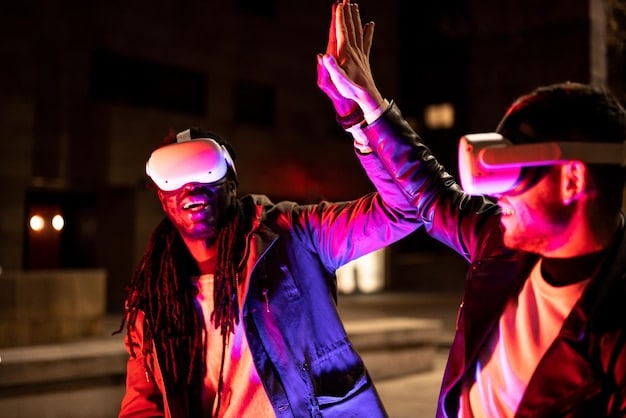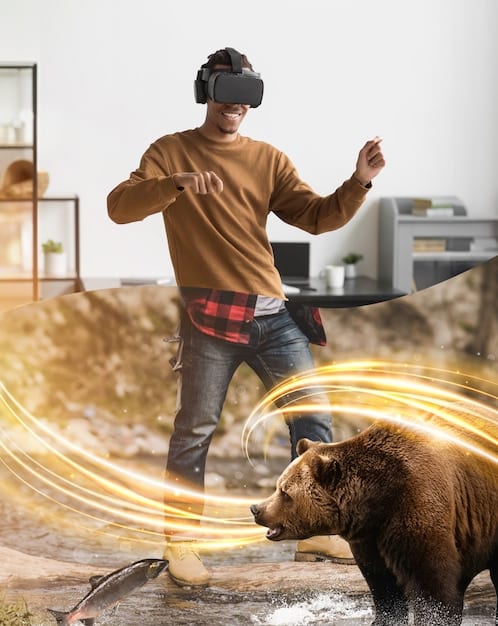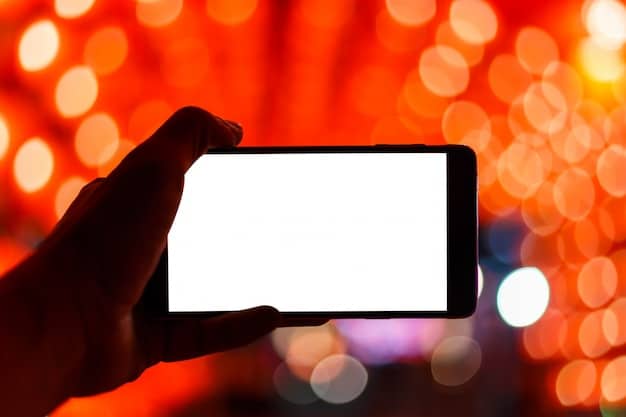The Future of Concerts: VR and Hybrid Experiences in the US

The future of concerts in the US is being reshaped by virtual reality and hybrid experiences, offering immersive and accessible entertainment options for audiences.
The live music scene is undergoing a dramatic transformation, and the future of concerts in the US is inextricably linked to the rise of virtual reality and hybrid experiences. As technology continues to evolve, it’s changing the way we experience live music.
The Evolution of Live Music: From Stadiums to Screens
Live music has always been a powerful force, bringing people together in shared experiences. However, the traditional concert model has limitations, including geographical constraints, high ticket prices, and accessibility issues. The rise of virtual reality (VR) and hybrid experiences is poised to break down these barriers and revolutionize how we enjoy live music in the US.
With advancements in technology, the future of concerts will involve a blend of in-person performances and digitally enhanced interactions. This evolution aims to cater to a broader audience while offering artists new avenues for creative expression and revenue generation.
The Limitations of Traditional Concerts
Traditional concerts, while offering a unique energy and atmosphere, are often limited by venue capacity, geographic location, and logistical challenges. The high costs of tickets, travel, and accommodations can also deter many potential concertgoers.
- Geographic Constraints: Fans are limited by where the artist is performing.
- High Ticket Prices: Concerts can be expensive, pricing out many fans.
- Accessibility Issues: Not everyone can physically attend concerts due to disability or distance.
These limitations highlight the need for innovative solutions that can broaden access to live music experiences. VR and hybrid experiences are emerging as viable alternatives, offering immersive and engaging entertainment options for a wider audience.
In conclusion, while traditional concerts will always hold a special place, the future requires us to consider more inclusive and accessible technologies. VR and hybrid events are not just trends; they are practical solutions that enhance the live music experience for everyone involved.
Virtual Reality Concerts: A New Dimension of Immersion
Virtual reality (VR) concerts offer a completely new way to experience live music. By donning a VR headset, fans can enter a virtual venue and feel like they’re right in the middle of the action, regardless of their physical location. This technology opens up possibilities for artists to create visually stunning and interactive performances that wouldn’t be possible in the real world.
VR concerts provide an immersive experience like no other, enhancing visual and auditory aspects while eliminating limitations imposed by physical spaces. The rise of VR concerts is part of a broader digital transformation reshaping the entertainment industry.

The Benefits of VR Concerts
VR concerts are revolutionizing access by eliminating geographical and financial constraints, fostering inclusivity and making live music more accessible.
- Accessibility: VR concerts eliminate geographical barriers, allowing fans from around the world to attend.
- Affordability: With reduced overhead costs, VR concert tickets can be more affordable than traditional ones.
- Immersive Experience: VR offers a heightened sense of presence and immersion, creating a unique emotional connection with the music.
These benefits have been recognized by both artists and fans, with many exploring the possibilities of VR concerts to connect in new and innovative ways.
In conclusion, VR concerts are not merely an alternative but a significant upgrade to traditional live music experiences. The immersive nature and broad accessibility redefine what it means to attend a concert, setting the stage for future innovation.
Hybrid Concerts: Blending Physical and Digital Worlds
Hybrid concerts combine the best of both worlds, bringing together live, in-person performances with virtual elements. These events allow artists to reach a wider audience by streaming the concert online, while also offering interactive features for remote viewers, such as live chats, virtual meet-and-greets, and personalized camera angles.
Hybrid concerts provide flexibility and reach by integrating live performances and digital engagement, attracting a broader audience and enhancing the overall experience for both in-person and remote attendees.
Examples of Successful Hybrid Concerts
Several examples of hybrid concerts demonstrate how live music can become an interactive and widely accessible experience. These showcases often incorporate innovative technologies to bridge the physical and digital divide, creating a more engaging concert environment.
- Live Streaming: Broadcasting live concerts to a global audience, allowing remote viewers to participate in real time.
- Interactive Elements: Live chats, Q&A sessions, and virtual meet-and-greets connecting artists with remote fans.
- Augmented Reality (AR): Overlaying digital graphics and effects onto the live performance, enhancing the visual experience for both in-person and remote attendees.
These hybrid approaches not only broaden the reach of live music but also add layers of interaction that enhance the overall experience for all fans, regardless of their physical location.
In conclusion, hybrid concerts exemplify the future of live music, merging the excitement of in-person experiences with the accessibility of digital platforms. This approach maximizes engagement and reach, allowing artists to connect with their audiences in innovative ways.
The Role of Technology: 5G, AR, and AI
Several technological advancements are playing a crucial role in shaping the future of concerts. 5G technology enables seamless streaming and low-latency interactions, while augmented reality (AR) can enhance live performances with digital overlays. Artificial intelligence (AI) can analyze audience data to personalize the concert experience and optimize sound quality.
These tools unlock new possibilities in how live music is created, delivered, and experienced. Combined, they enable personalized experiences, enhanced audience interaction, and improved concert logistics.

How Technology is Transforming Concerts
With technologies like 5G, AR and AI being used in concerts, events are being taken to a new level and expanding the possibilities for entertainment and audience engagement.
- 5G Technology: Provides high-speed connectivity and low latency, enabling seamless streaming and interactive experiences.
- Augmented Reality (AR): Overlays digital graphics onto the live performance, enhancing the visual experience for both in-person and remote attendees.
- Artificial Intelligence (AI): Analyzes audience data to personalize the concert experience, optimize sound quality, and manage logistics.
The integration of these technologies allows for more immersive, interactive, and personalized concert experiences, benefiting both performers and fans.
In conclusion, the role of technology in concerts is transformative, pushing the boundaries of what is possible in live music. Innovations like 5G, AR, and AI enhance fan engagement, personalize experiences, and improve logistical operations, ensuring every concert is memorable.
Challenges and Opportunities: Overcoming Obstacles
While VR and hybrid concerts offer immense potential, there are also challenges to overcome. These include ensuring high-quality audio-visual experiences, addressing concerns about digital equity, and finding ways to replicate the unique energy of live, in-person events.
Addressing these challenges will ensure that the benefits of technological advancements in live music are widely accessible and enjoyable. Embracing opportunities for growth will help transform VR and hybrid concerts into integral parts of the music industry.
Addressing the Challenges
Tackling these issues effectively will solidify the role of VR and hybrid concerts in the future of music entertainment.
- Ensuring High-Quality Experiences: Investing in advanced VR and streaming technologies can deliver immersive and visually stunning concerts.
- Addressing Digital Equity: Providing affordable access to VR headsets and high-speed internet can bridge the digital divide.
- Replicating the Energy of Live Events: Incorporating interactive elements, live chats, and virtual meet-and-greets can enhance engagement and create a sense of community.
By proactively addressing these challenges, the industry can ensure that the future of concerts is inclusive, engaging, and accessible to all.
In conclusion, though challenges persist, the opportunities presented by VR and hybrid concerts are vast. Strategic investments and inclusive practices can overcome obstacles and make the future of live music accessible and vibrant for everyone.
The Future Fan Experience: Personalized and Interactive
The concert experience of the future promises to be more personalized and interactive than ever before. Artists and event organizers can leverage technology to tailor performances to individual preferences, offering customized setlists, personalized shout-outs, and interactive virtual environments.
This shift enhances the connection between artists and fans, making live music a more inclusive and dynamic form of entertainment. The emphasis on customization reflects a broader trend in entertainment toward catering to individual tastes and preferences.
Enhancing Fan Engagement
Personalized and interactive experiences deepen fan engagement, ensuring live music remains a vital and exciting part of entertainment.
- Customized Setlists: Allowing fans to vote for their favorite songs, creating setlists tailored to audience preferences.
- Personalized Shout-Outs: Offering virtual meet-and-greets and personalized messages from artists to individual fans.
- Interactive Environments: Creating virtual concert environments where fans can interact with each other and the artist in real-time.
These individualized and interactive elements help build stronger artist-fan relationships and boost audience satisfaction, ensuring every attendee feels valued.
In conclusion, the future fan experience is set to transform live music into a personalized and highly engaging form of entertainment. Customization and interactivity will foster deeper connections between artists and fans, making each concert unique and memorable.
| Key Point | Brief Description |
|---|---|
| 🎤 Virtual Reality Concerts | Immersive experiences via VR headsets, removing geographical barriers. |
| 🌐 Hybrid Concerts | Blending live and virtual elements for broader audience reach. |
| 🚀 Role of Technology | 5G, AR, and AI enhance streaming, visual effects, and personalize experiences. |
| 🤝 Personalized Fan Experience | Customized setlists and interactive environments deepen fan engagement. |
Seção de FAQ Retrátil –>
What are virtual reality concerts?
Virtual reality concerts use VR headsets to provide an immersive concert experience from anywhere in the world as though you were present at a live show.
What benefits do hybrid concerts offer?
Hybrid concerts blend live in-person performances with virtual elements like live streams and augmented reality. These allow wider audience participation and interactive features such as chats and Q&A.
How does 5G technology enhance the future of concerts?
5G technology improves concert experiences with high-speed connectivity and low latency, enabling seamless high-quality live streaming and interactive features.
What role does augmented reality play in concerts?
Augmented reality enhances the visual aspects of concerts by overlaying digital effects and graphics onto live performances, creating an engaging experience for fans remotely.
How can artists personalize the fan experience in future concerts?
Artists can personalize fan experiences using interactive setlists, virtual meet-and-greets, and tailored messages using audience data for a specialized and exciting concert.
Conclusion
The future of concerts in the US is bright and evolving, significantly powered by the integration of virtual reality and hybrid experiences. These technological advancements are not just alternatives but enhancements that broaden access, deepen fan engagement, and offer artists new creative avenues. As challenges are addressed and opportunities are embraced, the live music scene in the US is poised for a revolution that promises more inclusive, immersive, and personalized experiences for all.





